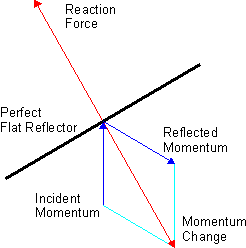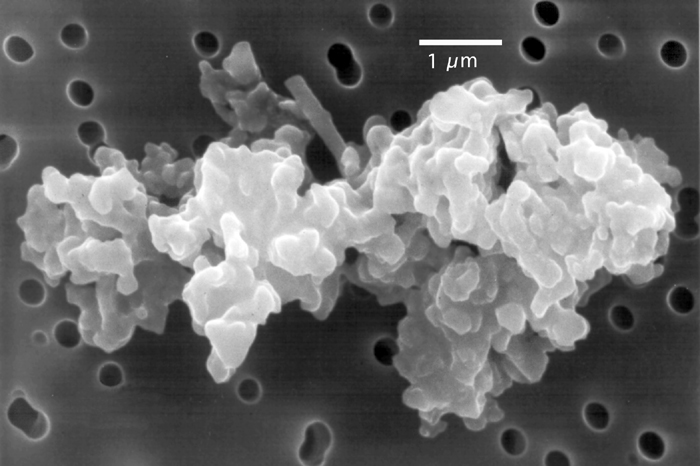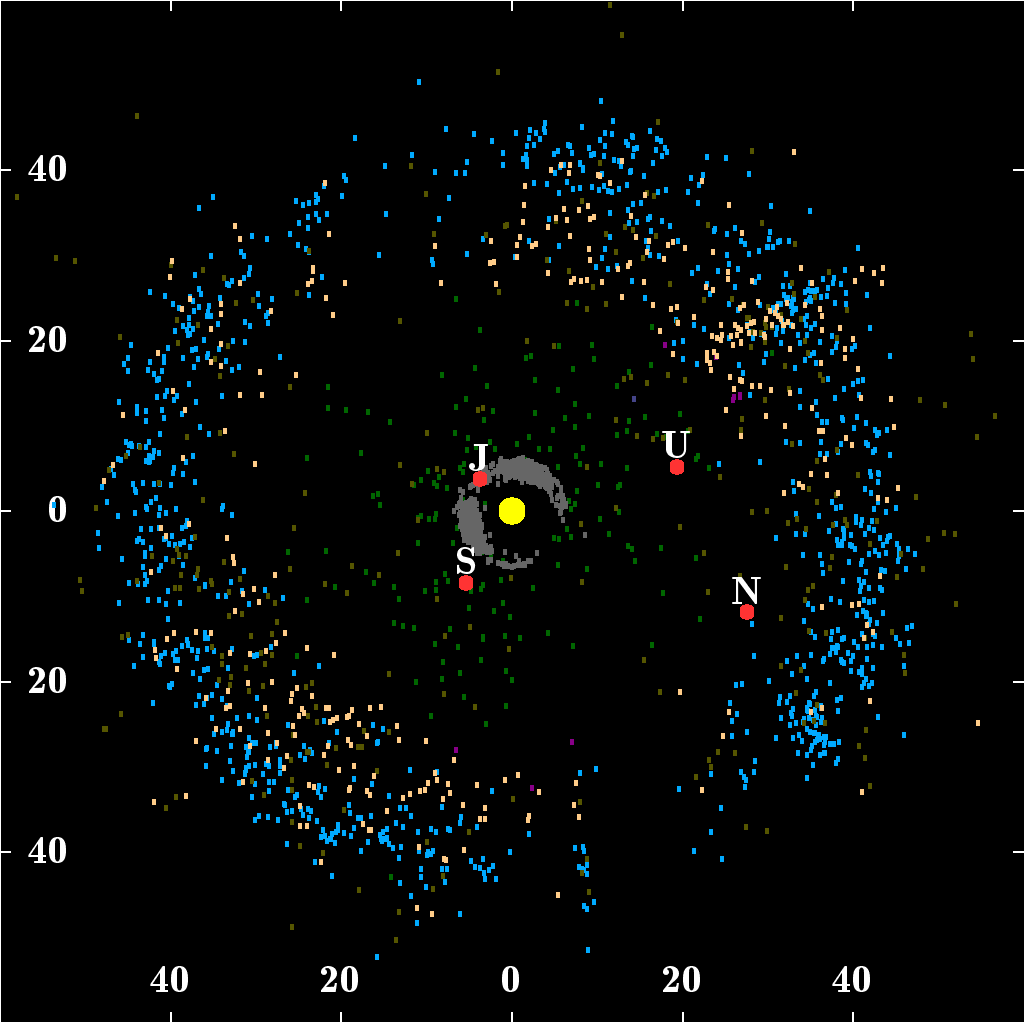|
Comet Tail
A comet tail and coma are visible features of a comet when they are illuminated by the Sun and may become visible from Earth when a comet passes through the inner Solar System. As a comet approaches the inner Solar System, solar radiation causes the volatile materials within the comet to vaporize and stream out of the nucleus, carrying dust away with them. Blown solar downwind, two separate tails are formed: one composed of dust and the other of gases. They become visible through different phenomena: the dust reflects sunlight directly, and the gases glow from ionization. Most comets are too faint to be visible without the aid of a telescope, but a few each decade become bright enough to be visible to the naked eye. Tail formation In the outer Solar System, comets remain frozen and are extremely difficult or impossible to detect from Earth due to their small size. Statistical detections of inactive comet nuclei in the Kuiper belt have been reported from the Hubble Space ... [...More Info...] [...Related Items...] OR: [Wikipedia] [Google] [Baidu] |
Anti-tail
An antitail, also known as an anti-tail, is an apparent spike projecting from a comet's Coma (cometary), coma which seems to go towards the Sun, and thus geometrically opposite to the other Comet tail, tails: the ''ion tail'' and the ''dust tail''. Despite a common misunderstanding, this phenomenon is not an optical illusion. The antitail consists of larger Comet dust, dust particles left behind by the comet. These dust particles are less affected by the Sun's Solar radiation pressure, radiation pressure and tend to remain roughly in the comet's orbital plane and eventually form a disc along the comet's orbit due to the ejection speed of the particles from the comet's surface. As Earth passes through the comet's orbital plane, this disc is seen side on, and appears as the characteristic spike. The other side of the disc can sometimes be seen, though it tends to be lost in the dust tail. The antitail is therefore normally visible for a brief interval only when Earth passes thro ... [...More Info...] [...Related Items...] OR: [Wikipedia] [Google] [Baidu] |
Ionization
Ionization or ionisation is the process by which an atom or a molecule acquires a negative or positive Electric charge, charge by gaining or losing electrons, often in conjunction with other chemical changes. The resulting electrically charged atom or molecule is called an ion. Ionization can result from the loss of an electron after collisions with subatomic particles, collisions with other atoms, molecules, electrons, positrons, protons, antiprotons, and ions, or through the interaction with electromagnetic radiation. Heterolytic bond cleavage and heterolytic substitution reactions can result in the formation of ion pairs. Ionization can occur through radioactive decay by the internal conversion process, in which an excited nucleus transfers its energy to one of the inner-shell electrons causing it to be ejected. Uses Everyday examples of gas ionization occur within a fluorescent lamp or other electrical discharge lamps. It is also used in radiation detectors such as the Geiger- ... [...More Info...] [...Related Items...] OR: [Wikipedia] [Google] [Baidu] |
Antitail
An antitail, also known as an anti-tail, is an apparent spike projecting from a comet's coma which seems to go towards the Sun, and thus geometrically opposite to the other tails: the ''ion tail'' and the ''dust tail''. Despite a common misunderstanding, this phenomenon is not an optical illusion. The antitail consists of larger dust particles left behind by the comet. These dust particles are less affected by the Sun's radiation pressure and tend to remain roughly in the comet's orbital plane and eventually form a disc along the comet's orbit due to the ejection speed of the particles from the comet's surface. As Earth passes through the comet's orbital plane, this disc is seen side on, and appears as the characteristic spike. The other side of the disc can sometimes be seen, though it tends to be lost in the dust tail. The antitail is therefore normally visible for a brief interval only when Earth passes through the comet's orbital plane. Most comets do not develop suffic ... [...More Info...] [...Related Items...] OR: [Wikipedia] [Google] [Baidu] |
Radiation Pressure
Radiation pressure (also known as light pressure) is mechanical pressure exerted upon a surface due to the exchange of momentum between the object and the electromagnetic field. This includes the momentum of light or electromagnetic radiation of any wavelength that is Absorption (electromagnetic radiation), absorbed, Reflection (physics), reflected, or otherwise emitted (e.g. black-body radiation) by matter on any scale (from macroscopic objects to dust particles to gas molecules). The associated force is called the radiation pressure force, or sometimes just the force of light. The forces generated by radiation pressure are generally too small to be noticed under everyday circumstances; however, they are important in some physical processes and technologies. This particularly includes objects in outer space, where it is usually the main force acting on objects besides gravity, and where the net effect of a tiny force may have a large cumulative effect over long periods of time. ... [...More Info...] [...Related Items...] OR: [Wikipedia] [Google] [Baidu] |
Coma (cometary)
The coma is the nebulous envelope around the nucleus of a comet, formed when the comet passes near the Sun in its highly elliptical orbit. As the comet warms, parts of it sublimate; this gives a comet a diffuse appearance when viewed through telescopes and distinguishes it from stars. The word ''coma'' comes from the Greek (), which means "hair" and is the origin of the word ''comet'' itself. The coma is generally made of ice and comet dust. Water composes up to 90% of the volatiles that outflow from the nucleus when the comet is within from the Sun. The H2O parent molecule is destroyed primarily through photodissociation and to a much smaller extent photoionization. The solar wind plays a minor role in the destruction of water compared to photochemistry. Larger dust particles are left along the comet's orbital path while smaller particles are pushed away from the Sun into the comet's tail by light pressure. On 11 August 2014, astronomers released studies, using the A ... [...More Info...] [...Related Items...] OR: [Wikipedia] [Google] [Baidu] |
Cosmic Dust
Cosmic dustalso called extraterrestrial dust, space dust, or star dustis dust that occurs in outer space or has fallen onto Earth. Most cosmic dust particles measure between a few molecules and , such as micrometeoroids (30 μm). Cosmic dust can be further distinguished by its astronomical location: intergalactic dust, interstellar dust, interplanetary dust (as in the zodiacal cloud), and circumplanetary dust (as in a planetary ring). There are several methods to obtain space dust measurement. In the Solar System, interplanetary dust causes the zodiacal light. Solar System dust includes comet dust, planetary dust (like from Mars), asteroidal dust, dust from the Kuiper belt, and interstellar dust passing through the Solar System. Thousands of tons of cosmic dust are estimated to reach Earth's surface every year, with most grains having a mass between 10−16 kg (0.1 pg) and 10−4 kg (0.1 g). The density of the dust cloud through which the Earth is traveling is approximately ... [...More Info...] [...Related Items...] OR: [Wikipedia] [Google] [Baidu] |
The Astronomical Journal
''The Astronomical Journal'' (often abbreviated ''AJ'' in scientific papers and references) is a peer-reviewed monthly scientific journal owned by the American Astronomical Society (AAS) and currently published by IOP Publishing. It is one of the premier journals for astronomy in the world. Until 2008, the journal was published by the University of Chicago Press on behalf of the AAS. The reasons for the change to the IOP were given by the society as the desire of the University of Chicago Press to revise its financial arrangement and their plans to change from the particular software that had been developed in-house. The other two publications of the society, the ''Astrophysical Journal'' and its supplement series, followed in January 2009. The journal was established in 1849 by Benjamin A. Gould. It ceased publication in 1861 due to the American Civil War, but resumed in 1885. Between 1909 and 1941 the journal was edited in Albany, New York. In 1941, editor Benjamin Boss arranged ... [...More Info...] [...Related Items...] OR: [Wikipedia] [Google] [Baidu] |
Astrophysical Journal Letters
''The Astrophysical Journal'' (''ApJ'') is a peer-reviewed scientific journal of astrophysics and astronomy, established in 1895 by American astronomers George Ellery Hale and James Edward Keeler. The journal discontinued its print edition and became an electronic-only journal in 2015. Since 1953, ''The Astrophysical Journal Supplement Series'' (''ApJS'') has been published in conjunction with ''The Astrophysical Journal'', with generally longer articles to supplement the material in the journal. It publishes six volumes per year, with two 280-page issues per volume. ''The Astrophysical Journal Letters'' (''ApJL''), established in 1967 by Subrahmanyan Chandrasekhar as Part 2 of ''The Astrophysical Journal'', is now a separate journal focusing on the rapid publication of high-impact astronomical research. The three journals were published by the University of Chicago Press for the American Astronomical Society until, in January 2009, publication was transferred to IOP Publishi ... [...More Info...] [...Related Items...] OR: [Wikipedia] [Google] [Baidu] |
The Astrophysical Journal
''The Astrophysical Journal'' (''ApJ'') is a peer-reviewed scientific journal of astrophysics and astronomy, established in 1895 by American astronomers George Ellery Hale and James Edward Keeler. The journal discontinued its print edition and became an electronic-only journal in 2015. Since 1953, ''The Astrophysical Journal Supplement Series'' (''ApJS'') has been published in conjunction with ''The Astrophysical Journal'', with generally longer articles to supplement the material in the journal. It publishes six volumes per year, with two 280-page issues per volume. ''The Astrophysical Journal Letters'' (''ApJL''), established in 1967 by Subrahmanyan Chandrasekhar as Part 2 of ''The Astrophysical Journal'', is now a separate journal focusing on the rapid publication of high-impact astronomical research. The three journals were published by the University of Chicago Press for the American Astronomical Society until, in January 2009, publication was transferred to IOP Publis ... [...More Info...] [...Related Items...] OR: [Wikipedia] [Google] [Baidu] |
Hubble Space Telescope
The Hubble Space Telescope (HST or Hubble) is a space telescope that was launched into low Earth orbit in 1990 and remains in operation. It was not the Orbiting Solar Observatory, first space telescope, but it is one of the largest and most versatile, renowned as a vital research tool and as a public relations boon for astronomy. The Hubble Space Telescope is named after astronomer Edwin Hubble and is one of NASA's Great Observatories program, Great Observatories. The Space Telescope Science Institute (STScI) selects Hubble's targets and processes the resulting data, while the Goddard Space Flight Center (GSFC) controls the spacecraft. Hubble features a mirror, and its five main instruments observe in the ultraviolet, visible spectrum, visible, and near-infrared regions of the electromagnetic spectrum. Hubble's orbit outside the distortion of atmosphere of Earth, Earth's atmosphere allows it to capture extremely high-resolution images with substantially lower background lig ... [...More Info...] [...Related Items...] OR: [Wikipedia] [Google] [Baidu] |
Kuiper Belt
The Kuiper belt ( ) is a circumstellar disc in the outer Solar System, extending from the orbit of Neptune at 30 astronomical units (AU) to approximately 50 AU from the Sun. It is similar to the asteroid belt, but is far larger—20 times as wide and 20–200 times as massive. Like the asteroid belt, it consists mainly of small Solar System body, small bodies or remnants from when the Formation and evolution of the Solar System, Solar System formed. While many asteroids are composed primarily of rock (geology), rock and metal, most Kuiper belt objects are composed largely of frozen Volatile (astrogeology), volatiles (termed "ices"), such as methane, ammonia, and water. The Kuiper belt is home to most of the objects that astronomers generally accept as dwarf planets: 90482 Orcus, Orcus, Pluto, Haumea, 50000 Quaoar, Quaoar, and Makemake. Some of the Solar System's natural satellite, moons, such as Neptune's Triton (moon), Triton and Saturn's Phoebe (moon), Phoebe, may ha ... [...More Info...] [...Related Items...] OR: [Wikipedia] [Google] [Baidu] |
Anti-tail
An antitail, also known as an anti-tail, is an apparent spike projecting from a comet's Coma (cometary), coma which seems to go towards the Sun, and thus geometrically opposite to the other Comet tail, tails: the ''ion tail'' and the ''dust tail''. Despite a common misunderstanding, this phenomenon is not an optical illusion. The antitail consists of larger Comet dust, dust particles left behind by the comet. These dust particles are less affected by the Sun's Solar radiation pressure, radiation pressure and tend to remain roughly in the comet's orbital plane and eventually form a disc along the comet's orbit due to the ejection speed of the particles from the comet's surface. As Earth passes through the comet's orbital plane, this disc is seen side on, and appears as the characteristic spike. The other side of the disc can sometimes be seen, though it tends to be lost in the dust tail. The antitail is therefore normally visible for a brief interval only when Earth passes thro ... [...More Info...] [...Related Items...] OR: [Wikipedia] [Google] [Baidu] |









